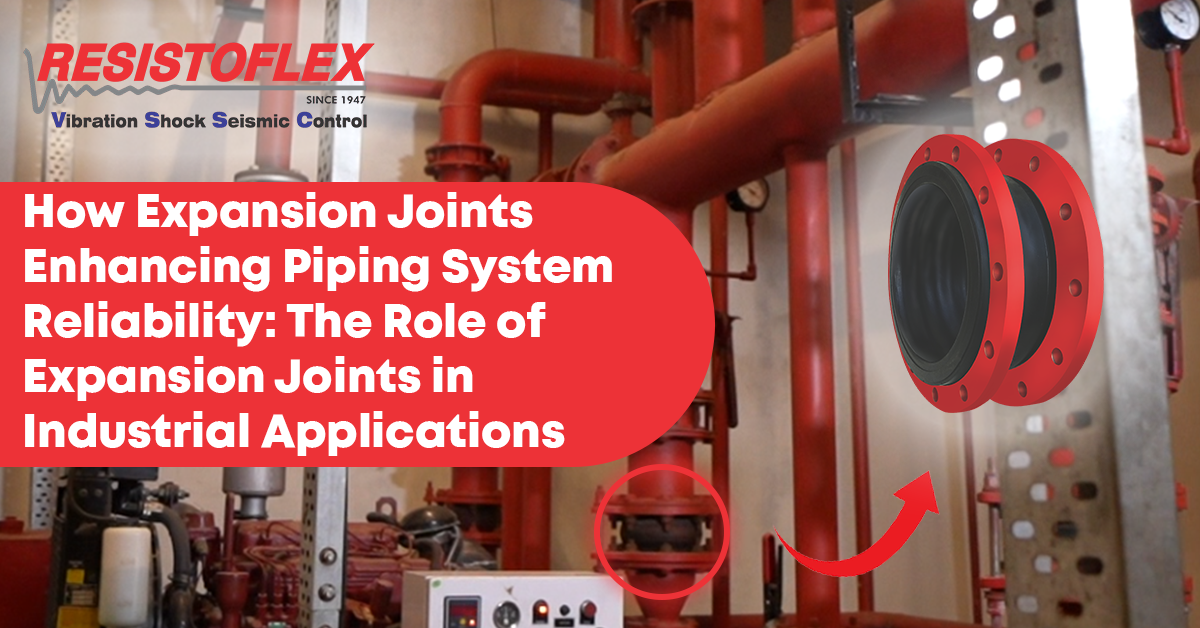The Role of Expansion Joints in Industrial Applications.
How Expansion Joints Enhancing Piping System Reliability: The Role of Expansion Joints in Industrial Applications.

Introduction
Piping systems are critical parts of many industrial setups, from power plants to chemical factories. These systems often face stress, vibrations, and misalignment due to temperature changes, mechanical equipment, and ground movements. Without proper protection, pipes can crack, leak, or fail, causing costly downtime and repairs.
Expansion joints are engineered components designed to accommodate thermal expansion, contraction, vibration, and other mechanical stresses within piping systems. They function by absorbing dynamic forces and facilitating controlled axial, lateral, and angular movements, thereby preserving the structural integrity and operational reliability of the system.
What Are Expansion Joints?
Expansion joints are flexible connectors installed between sections of piping to absorb vibration and movement and reduce stress. They allow pipes to expand, contract, and move slightly without damage.
There are mainly two types:
Rubber Expansion Joints
Rubber expansion joints are made from high-strength elastomers and reinforced with durable nylon cords, metal rings, and wires. They are highly effective in absorbing vibrations and compensating for minor misalignments.
Key Features:
- Made using high-strength nylon cord fabric and elastomer.
- Reinforced with metal rings and wires for strength.
- Integral full-faced flanges seamlessly fused with the body.
- Efficient sealing surface – no gasket required.
Rubber Expansion Joints by Resistoflex:
- Single Arch Rubber Expansion Joint with Retaining Ring & Control Unit
- Single Arch Rubber Expansion Joint with Control Unit
- Double Arch Rubber Expansion Joints
- Flexible Rubber Connector with Standard Union Ends
- Flexible Rubber Connector with Flanged Union Ends
Explore our full range of Rubber Expansion Joints by Resistoflex
Metallic Expansion Joints
These are made from corrosion-resistant stainless steel and are ideal for high-pressure and high-temperature applications.
Key Features:
- Absorbs axial, lateral, and angular movements effectively.
- Reduces vibration and noise in pipelines.
- Built for high durability in extreme environments.
- Ideal for power plants, chemical industries, marine systems, and exhaust pipelines.
Explore Metallic Expansion Joints by Resistoflex
How Stress Occurs in Piping Systems
Pipes undergo thermal expansion and contraction due to temperature changes during operation. This repeated movement creates stress on the pipe walls and joints.
Other stress sources include:
- Pressure surges or water hammer
- External mechanical loads
- Seismic activity or structural deflection
Without protection, this stress can cause cracks or joint failure.
How Expansion Joints Absorb Stress
Expansion joints are designed to absorb different types of movement caused by stress:
- Axial Movement: Movement along the length of the pipe
- Lateral Movement: Sideways movement
- Angular Movement: Bending or rotation
By absorbing these movements, expansion joints prevent excessive force on pipes and joints, reducing the risk of damage.
For example, metallic expansion joints from Resistoflex are engineered to handle heavy thermal stress, making them ideal for steam or hot fluid pipelines.
Absorbing Vibration and Reducing Noise
Mechanical equipment like pumps and compressors generates vibration, which travels through piping and can cause fatigue failure or leaks.
Rubber expansion joints are very effective in absorbing these vibrations and reducing noise because of their flexible rubber construction.
Resistoflex rubber expansion joints even feature designs like dual arch shapes that reduce system surges and start-up forces, protecting your piping system better.
Compensating for Misalignment
During installation or over time due to ground settlement, pipes may not stay perfectly aligned. Misalignment puts extra strain on pipe connections and can cause leaks.
Expansion joints compensate for:
- Angular misalignment
- Lateral misalignment
This flexibility allows piping systems to accommodate minor errors or shifts without damage.
Installation and Maintenance Tips
Even the best expansion joints need proper installation and maintenance for optimal performance:
Expansion joints compensate for:
- Ensure correct flange-to-flange measurement to avoid joint over-compression or extension.
- Use proper anchoring and guiding to control pipe movement and avoid unnecessary stress or to use Control unit as recommended.
- Regularly inspect joints for wear, cracks, or leaks.
Proper installation and upkeep extend the service life of expansion joints and protect the entire piping system.
Conclusion
Expansion joints are essential in protecting piping systems from stress caused by thermal movement, vibration, and misalignment. By absorbing movement and reducing forces on pipes, they prevent damage, leaks, and costly downtime.
Choosing the right expansion joint—rubber or metallic—based on your system’s pressure, temperature, and movement needs is critical.
For trusted, quality expansion joints designed to meet these needs, check out Resistoflex’s wide range of:
These products are engineered for durability, performance, and compliance, helping you safeguard your piping systems effectively.Rubber expansion joints for pipelines. How expansion joints reduce vibration in pipes
“Best expansion joints for industrial piping systems”


